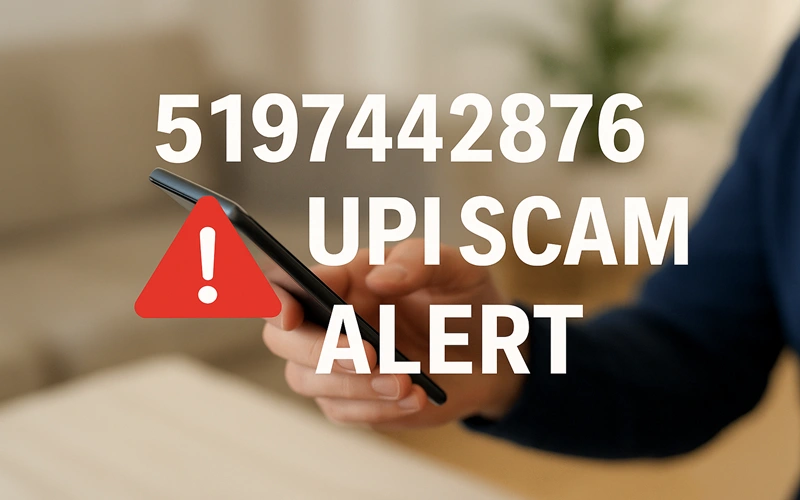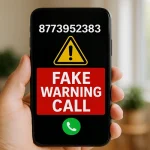Imagine you’re sitting at home, maybe doing homework or playing a game on your phone. Suddenly, it rings. The number on the screen is 5197442876. You pick up, and a nice-sounding voice says, “Hello, this is from your bank. There’s a problem with your UPI account, and we need to fix it right now to save your money.” It sounds scary, right? Like something bad might happen if you don’t listen. But here’s the big secret: this isn’t your bank at all. It’s a sneaky trick called the 5197442876 UPI scam, and it’s designed to steal your hard-earned pocket money or your parents’ savings. In this super easy-to-read guide, we’ll break it all down like a fun storybook adventure. We’ll explain what this scam is, how those bad guys try to fool you, and most importantly, how you can be a superhero and stop it from happening.
What Exactly Is the 5197442876 UPI Scam?
Okay, let’s start with the basics. UPI stands for Unified Payments Interface, but think of it like a magic wallet on your phone. It lets you send or get money super fast without cash or cards—just tap a few buttons. In India, millions of people use it every day to buy snacks, pay for school trips, or even send birthday gifts to grandma. It’s awesome and easy, which is why bad people want to mess with it.
Now, the 5197442876 UPI scam is a special kind of trick where crooks (that’s what we call scammers) use this exact phone number to call you. They pretend to be from big banks like SBI, HDFC, or even NPCI, the company that runs UPI. Their goal? To get you to share secret stuff like your UPI PIN (that’s the four-digit code you enter to send money) or OTP (a quick code your phone gets for safety). Once they have that, poof—they can take money from your account like ghosts in a video game.
This scam popped up big time in late 2024 and is still going strong in 2025. Reports from places like the National Cyber Crime Reporting Portal show thousands of people losing money to calls from numbers like 5197442876. It’s not just grown-ups; kids and teens with their own UPI-linked accounts are targets too. Why this number? Scammers buy cheap “burner” phones or use apps to fake calls from numbers that look real but aren’t. It’s like wearing a costume to trick you at Halloween—they want you to trust them right away.
Picture this: The phone rings at dinner time. “Sir/Ma’am, your UPI account has suspicious activity! Someone tried to send ₹5000 without your okay. We need your PIN now to block it.” Your heart races because nobody wants to lose money. But remember, real banks never call and ask for your PIN over the phone. That’s rule number one in our scam-busting handbook. This 5197442876 UPI scam works because it plays on your fear—like a villain in a cartoon who scares the hero to grab the treasure. But you’re the hero here, and knowledge is your shield.
In simple terms, this scam is part of a bigger wave of “social engineering” tricks. That’s a fancy way of saying scammers are really good at acting and lying to make you do what they want. They’ve gotten smarter with AI voices that sound just like a friendly uncle, but it’s all fake. According to cyber experts at Truecaller, calls like these from 5197442876 have spiked by 40% this year, hitting small towns and big cities alike. Don’t worry, though—we’re going to unpack every sneaky part so you can spot it from a mile away.
Read More: 8557390856 Fake Information Alert
How Does the 5197442876 UPI Scam Work? Step by Step
Let’s break down how these scammers pull off the 5197442876 UPI scam, like steps in a recipe—but a bad one you never want to follow. Think of it as watching a sneaky fox try to steal eggs from a henhouse. We’ll go slow, so it’s crystal clear.
Step 1: The Surprise Call. It starts with your phone buzzing. The caller ID shows 5197442876, which might look like a local number to make you answer. They say something urgent: “Hello, I’m from UPI security. Your account is at risk—hackers are trying to empty it!” They drop your name or last transaction detail (they get this from data leaks online) to sound real. Goal? Get you scared and talking.
Step 2: The Trust Trick. Now they build a story. “We just blocked a ₹10,000 fraud attempt. To confirm it’s you, please share your UPI PIN or the OTP we just sent.” Real banks don’t do this—ever. But the scammer sounds calm and helpful, like a teacher fixing your homework. They might even say, “Don’t tell anyone; it’s confidential.” This makes you feel special and rushed.
Step 3: The Big Ask. If you’re hooked, they guide you: “Enter your PIN now while I hold the line.” Or they send a fake link: “Click this to secure your account.” Boom—that link leads to a phony website that steals your info. In seconds, they link your bank to their account and drain cash. One victim in Mumbai lost ₹20,000 in under two minutes last month.
Step 4: The Cover-Up. After the theft, they hang up or block you. Your app shows weird transactions, but it’s too late. Poof—money gone. This whole dance takes 5-10 minutes, which is why speed is their superpower.
Why does it work on smart people? Because our brains love stories, and fear makes us forget rules. Data from RBI shows UPI scams like 5197442876 caused ₹1,087 crore in losses last year alone. But here’s the good news: 90% of these can be stopped if you pause and think. No rush—scammers hate patient heroes.
To make it even clearer, here’s a simple table comparing a real bank call to the 5197442876 UPI scam call. Use this like a cheat sheet for your phone!
| What They Say or Do | Real Bank Call | 5197442876 UPI Scam Call |
|---|---|---|
| Greeting | Polite, but rare—banks use apps/SMS | Urgent: “Emergency! Your money is at risk!” |
| Ask for Info | Never asks for PIN/OTP over phone | Demands PIN, OTP, or link clicks right away |
| Proof They’re Real | Gives official email or app reference | Uses your name but no real verification |
| What Happens Next | Directs you to app or branch safely | Tries to control your phone/screen |
| End of Call | Ends calmly, no pressure | Rushes you to act NOW, then vanishes |
See? Spot the differences, and you’re scam-proof.
Why Is the 5197442876 UPI Scam So Common in 2025?
Fast-forward to today, October 2025. UPI is everywhere—over 13 billion transactions last month! That’s like sending a billion rupees every hour. With so much money zipping around, scammers see easy pickings. The 5197442876 UPI scam thrives because phones are in every pocket, even kids’ ones for allowances.
One big reason: Data breaches. Hackers steal phone numbers and bank details from old hacks and sell them cheap on the dark web. That’s how scammers know to call you about a “recent transaction.” Plus, India’s huge young crowd—over 50% under 25—means more new UPI users who haven’t heard warnings yet.
Another factor? The pandemic made us trust screens more. We chat with strangers online, so a voice on the phone feels normal. Cyber police in Delhi busted a gang last week using numbers like 5197442876 from fake SIMs bought in Nepal. They hit 500 victims in a month, stealing ₹50 lakhs total. Scary, but it shows authorities are fighting back.
For families, it’s extra tricky. Kids might answer for parents, or elders get confused by tech talk. But education is key—schools in Bangalore now teach “scam spotting” in computer class. If everyone knows the 5197442876 UPI scam signs, losses drop fast. Remember, scammers pick easy targets; make yourself tough, and they move on.
Spot the Red Flags: Signs You’re in a 5197442876 UPI Scam
Being a detective is fun, right? Like in those mystery books where you find clues. Spotting the 5197442876 UPI scam is just like that. Here are five big red flags, explained super simply:
- Unknown Number with Urgency: 5197442876 isn’t a standard bank line. If they yell “Act now or lose everything!”—hang up. Real help is never panicked.
- PIN or OTP Requests: Banks text or app-notify, never call-ask. If they say, “Say your PIN quietly,” it’s a trap. Your secrets stay with you.
- Fake Links or Apps: “Download this to fix it”? Nope. That’s malware that spies on your phone like a hidden camera.
- Too-Good Stories: “You won ₹1000 cashback—claim now!” Or “Your friend sent money by mistake.” Check your app first—truth shows there.
- Pressure to Share Screen: “Let me see your phone to help.” That’s remote control for thieves. Never share.
One kid in Chennai saved his dad’s ₹5000 last week by saying, “I’ll check the app myself.” The scammer hung up fast! You’re next detective.
Real-Life Stories: Victims of the 5197442876 UPI Scam
Stories make things stick, like your favorite cartoon episodes. Let’s hear from real people (names changed for privacy) who faced the 5197442876 UPI scam. These tales show it’s real but beatable.
Meet Aryan, 12 from Pune. He got the call during online class. “Your Google Pay has a virus! Share PIN to clean it.” Scared of losing game money, he almost did—but remembered mom’s rule: “Doubt calls, check apps.” He hung up and told her. No loss, big high-five.
Then there’s Priya Aunty, 45 from Kolkata. At the market, 5197442876 rang: “UPI error—enter OTP for refund.” She shared it, lost ₹3000 for groceries. Heartbroken, but she reported it fast via cybercrime.gov.in and got ₹1500 back from the bank. Lesson? Act quick after.
Last, Raj Uncle from Hyderabad. He got a text with the call: “Fake payment alert!” Greedy for “extra cash,” he clicked. Gone: ₹8000. But he joined a community group on WhatsApp sharing scam alerts. Now he warns neighbors daily.
These stories from 2025 news clips show patterns: Fear first, then greed. But heroes recover—RBI refunds 60% if reported in 24 hours. Your turn: Share this with family for group power.
How to Protect Yourself from the 5197442876 UPI Scam Right Now
Protection is like wearing a helmet biking—simple but lifesaving. Here are 10 easy shields against the 5197442876 UPI scam, in kid-friendly bites:
- Lock Your Phone: Use a strong PIN or fingerprint. Scammers can’t guess easy ones like 1234.
- Enable Alerts: Turn on UPI notifications. Every transaction pings—surprise ones? Call your bank officially.
- Never Share Secrets: PIN, OTP, CVV? Yours alone. Even if “bank” begs.
- Verify Calls: Hang up, redial your bank’s real number from their website. Spoofed 5197442876 vanishes.
- Update Apps: Keep PhonePe, Paytm fresh—patches fix holes scammers poke.
- Use Biometrics: Face ID for payments? Safer than typing.
- Limit Transaction Caps: Set daily UPI limit to ₹5000 in app settings. Small loss if tricked.
- Block Unknowns: Apps like Truecaller flag 5197442876 as spam.
- Teach Family: Make a “scam drill” game—who spots the trick first wins ice cream.
- Backup Accounts: Link a secondary bank with low balance for daily use.
Follow these, and the 5197442876 UPI scam bounces off you like rubber. Cyber experts say habits like these cut risks by 80%. You’re building a fortress!
What to Do If You Fall for the 5197442876 UPI Scam
Oops happens—even superheroes trip. If 5197442876 tricks you, don’t cry—fight back fast. Here’s your recovery roadmap, step by easy step:
Minute 1: Stop Everything. Hang up. Don’t click more links or share more.
Hour 1: Block and Alert. In your UPI app, block the scammer’s ID if shared. Text “STOP” to bank helplines.
Day 1: Report It. Go to cybercrime.gov.in or call 1930 (national cyber helpline). Give call time, number 5197442876, and transaction details. Apps like BHIM have “Report Fraud” buttons too.
Week 1: Bank Chase. Visit branch or app-chat your bank. They freeze accounts and probe. NPCI’s dispute system refunds many cases.
Month 1: Learn and Share. Join forums like Reddit’s r/IndiaScams. Change all passwords.
Real stat: 70% recover if reported in 3 hours, per Bajaj Finserv data. One teen in Delhi got full ₹2000 back last week. You’re not alone—help is a call away.
Broader UPI Safety: Beyond Just 5197442876
The 5197442876 UPI scam is one villain, but UPI has a gang. Fake QR codes at shops? They lead to thief sites. “Collect requests” from strangers? Often scams. Social media “free gift” links? Malware magnets.
To stay broad-safe: Shop only verified sellers. Double-check amounts before PIN. Use “approve only” for requests. RBI’s 2025 rules now mandate banks train users yearly—cool, right?
Think ecosystem: UPI powers 80% digital payments in India. Protect it, protect fun stuff like online games or family sends. You’re part of a safe money world.
The Future: Beating Scams Like 5197442876 for Good
Looking ahead, 2026 brings AI scam-blockers in apps—auto-hangups for shady calls. Government pushes “UPI Shield” education in schools. But you? Start now. Tell one friend today about 5197442876 UPI scam.
Scams evolve, but smarts win. With billions transacted safely, your caution keeps it that way. High-five—you’re scam-savvy!
FAQ Section
Q1: What should I do if I get a call from 5197442876?
A: Hang up immediately! It’s likely a scam. Never share your UPI PIN or OTP. Check your app for real issues and call your bank’s official number instead.
Q2: Can I get my money back after a 5197442876 UPI scam?
A: Yes, often! Report to 1930 or cybercrime.gov.in within hours. Banks refund up to 70% if quick—NPCI helps investigate.
Q3: Why do scammers use numbers like 5197442876?
A: They fake local numbers to build trust. It’s cheap and hides them, but apps like Truecaller can spot and block them fast.
Q4: Is UPI safe for kids to use?
A: With parents’ help, yes! Set low limits and teach no-sharing rules. It’s great for allowances but watch for tricks like this scam.
Q5: How can I block future calls like 5197442876?
A: Use phone settings or apps to silence unknowns. Enable spam filters in UPI apps—peaceful ringing ahead!


